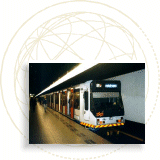São
Paulo - Mêtro
Crime and insecurity
 In spite of the high pressure on the speed of construction and
the lack of financial means, the São Paulo metro system
developed into a highly adequate and relatively safe system. Efficiency
rates and service quality are high. Prices are affordable, even
for members of the underprivileged class. The stations and trains
are tastefully designed, clean, and well-maintained. Crime rates
are significantly lower than that on the street. In 1990, 5.1
passengers out of a million became victimised by property crime
in the metro system of São Paulo. In 1994, this number
had decreased to 4.2 passengers per million. Robbery of ticketsellers
used to be a problem in 1991 when there was a total of 115 cases.
In 1994, this number had, however, decreased to 30 incidents.
The number of vandalism cases was only 258 in 1991 and has, after
a rapid increase in 1992, stabilised to around 638 cases in 1994.
The problem of crime is only a minor problem when compared with
the high number of health problems with which the metro company
is dealing every year. In 1994, there were 3,880 recorded crime
cases, 2,092 accidents, and 12,957 health problems. The majority
of health problems occur during the summer months when many underprivileged
metro passengers faint due to hunger.
In spite of the high pressure on the speed of construction and
the lack of financial means, the São Paulo metro system
developed into a highly adequate and relatively safe system. Efficiency
rates and service quality are high. Prices are affordable, even
for members of the underprivileged class. The stations and trains
are tastefully designed, clean, and well-maintained. Crime rates
are significantly lower than that on the street. In 1990, 5.1
passengers out of a million became victimised by property crime
in the metro system of São Paulo. In 1994, this number
had decreased to 4.2 passengers per million. Robbery of ticketsellers
used to be a problem in 1991 when there was a total of 115 cases.
In 1994, this number had, however, decreased to 30 incidents.
The number of vandalism cases was only 258 in 1991 and has, after
a rapid increase in 1992, stabilised to around 638 cases in 1994.
The problem of crime is only a minor problem when compared with
the high number of health problems with which the metro company
is dealing every year. In 1994, there were 3,880 recorded crime
cases, 2,092 accidents, and 12,957 health problems. The majority
of health problems occur during the summer months when many underprivileged
metro passengers faint due to hunger.
|
Source: López, M.J.J., Crime Prevention
Guidelines for the Construction & Management of Metro Systems,
Den Haag: RCM-advies 1996, pg. 26-28.
 Order
this book Order
this book
|

 In spite of the high pressure on the speed of construction and
the lack of financial means, the São Paulo metro system
developed into a highly adequate and relatively safe system. Efficiency
rates and service quality are high. Prices are affordable, even
for members of the underprivileged class. The stations and trains
are tastefully designed, clean, and well-maintained. Crime rates
are significantly lower than that on the street. In 1990, 5.1
passengers out of a million became victimised by property crime
in the metro system of São Paulo. In 1994, this number
had decreased to 4.2 passengers per million. Robbery of ticketsellers
used to be a problem in 1991 when there was a total of 115 cases.
In 1994, this number had, however, decreased to 30 incidents.
The number of vandalism cases was only 258 in 1991 and has, after
a rapid increase in 1992, stabilised to around 638 cases in 1994.
The problem of crime is only a minor problem when compared with
the high number of health problems with which the metro company
is dealing every year. In 1994, there were 3,880 recorded crime
cases, 2,092 accidents, and 12,957 health problems. The majority
of health problems occur during the summer months when many underprivileged
metro passengers faint due to hunger.
In spite of the high pressure on the speed of construction and
the lack of financial means, the São Paulo metro system
developed into a highly adequate and relatively safe system. Efficiency
rates and service quality are high. Prices are affordable, even
for members of the underprivileged class. The stations and trains
are tastefully designed, clean, and well-maintained. Crime rates
are significantly lower than that on the street. In 1990, 5.1
passengers out of a million became victimised by property crime
in the metro system of São Paulo. In 1994, this number
had decreased to 4.2 passengers per million. Robbery of ticketsellers
used to be a problem in 1991 when there was a total of 115 cases.
In 1994, this number had, however, decreased to 30 incidents.
The number of vandalism cases was only 258 in 1991 and has, after
a rapid increase in 1992, stabilised to around 638 cases in 1994.
The problem of crime is only a minor problem when compared with
the high number of health problems with which the metro company
is dealing every year. In 1994, there were 3,880 recorded crime
cases, 2,092 accidents, and 12,957 health problems. The majority
of health problems occur during the summer months when many underprivileged
metro passengers faint due to hunger. Order
this book
Order
this book